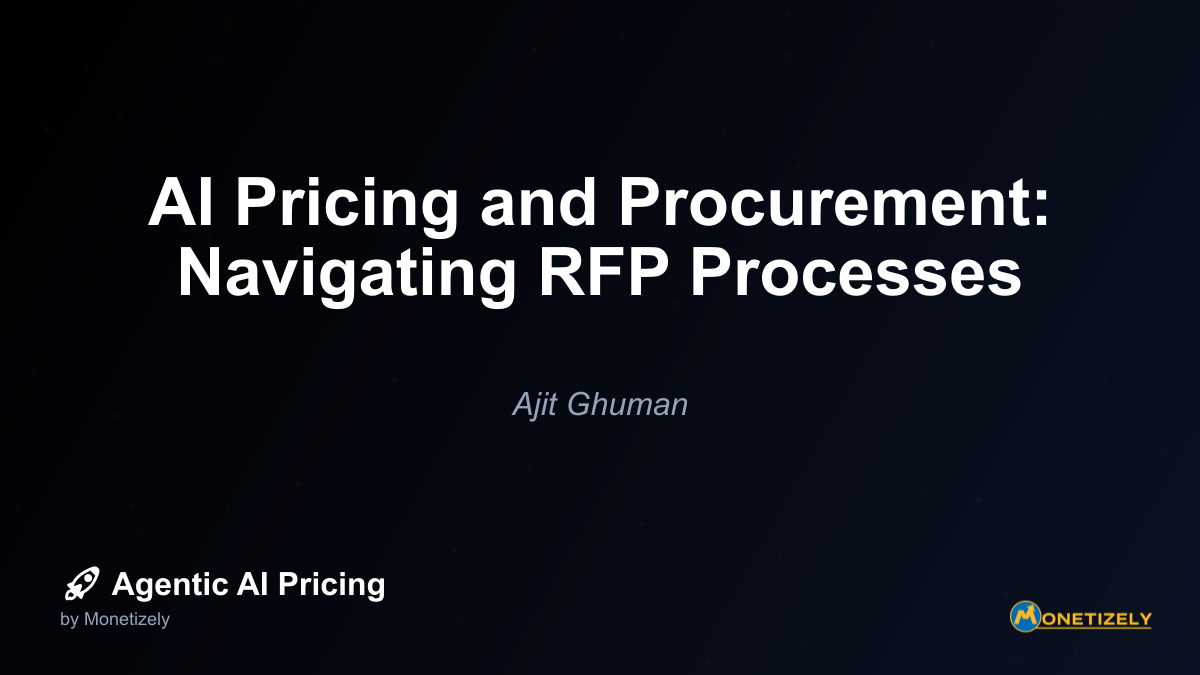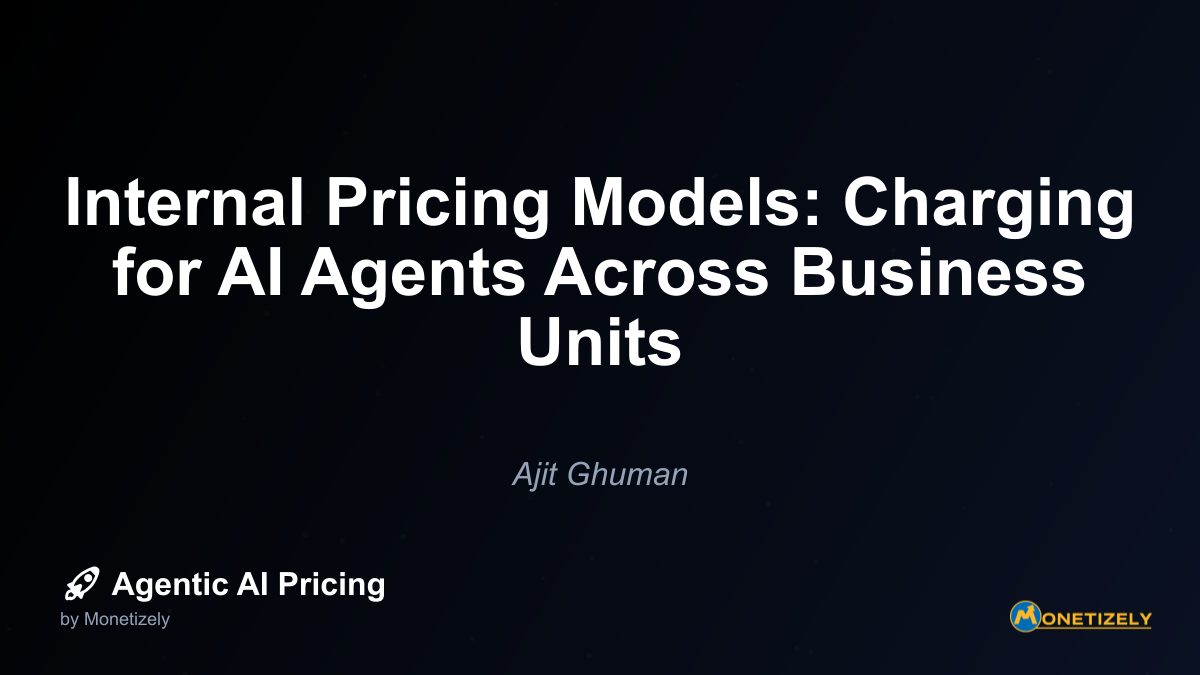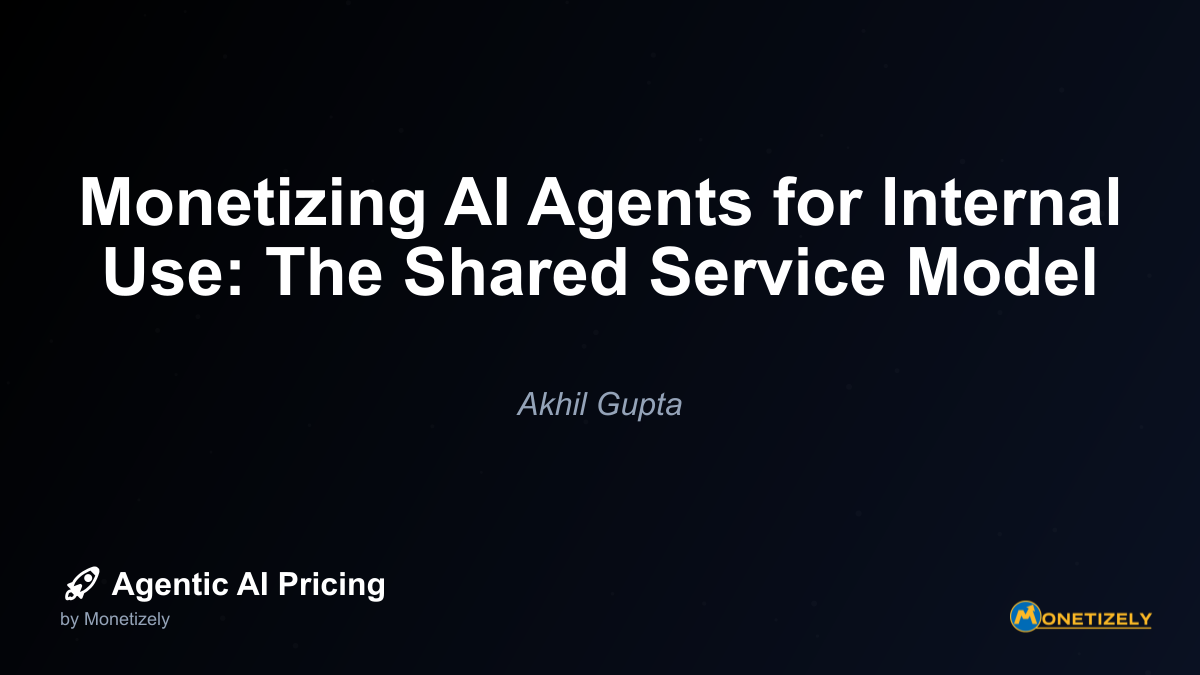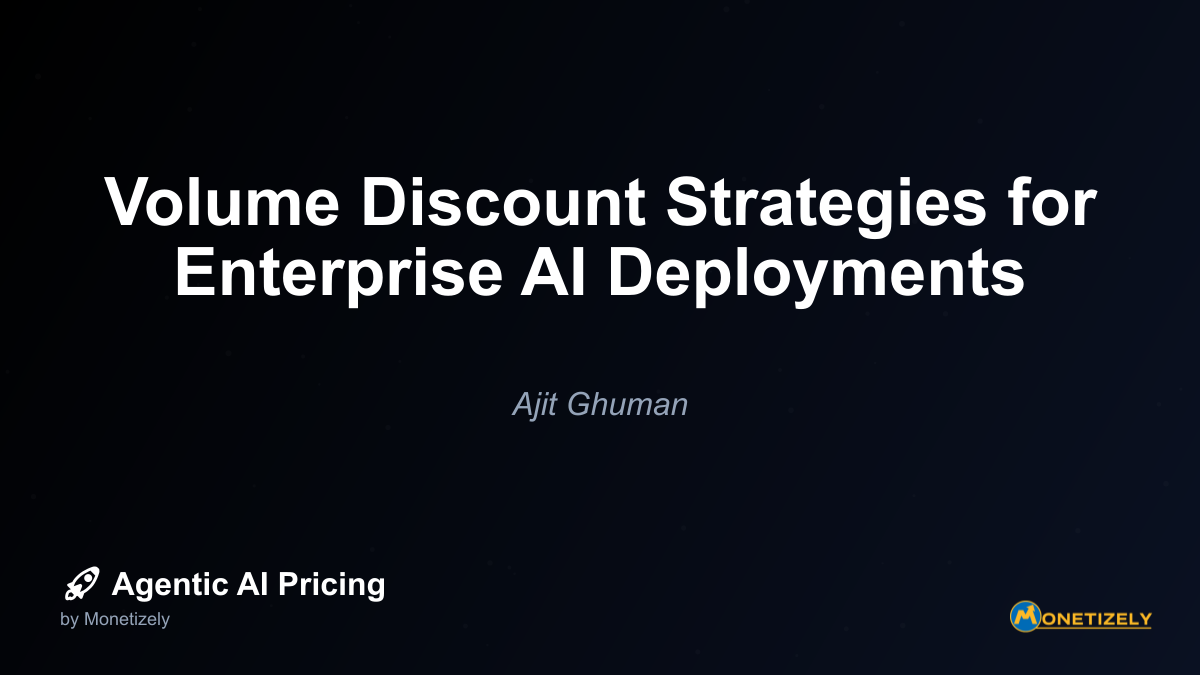· Akhil Gupta · Enterprise · 13 min read
Negotiation Strategies for Enterprise AI Deals: Vendor Perspective
AI and SaaS Pricing Masterclass
Learn the art of strategic pricing directly from industry experts. Our comprehensive course provides frameworks and methodologies for optimizing your pricing strategy in the evolving AI landscape. Earn a professional certification that can be imported directly to your LinkedIn profile.
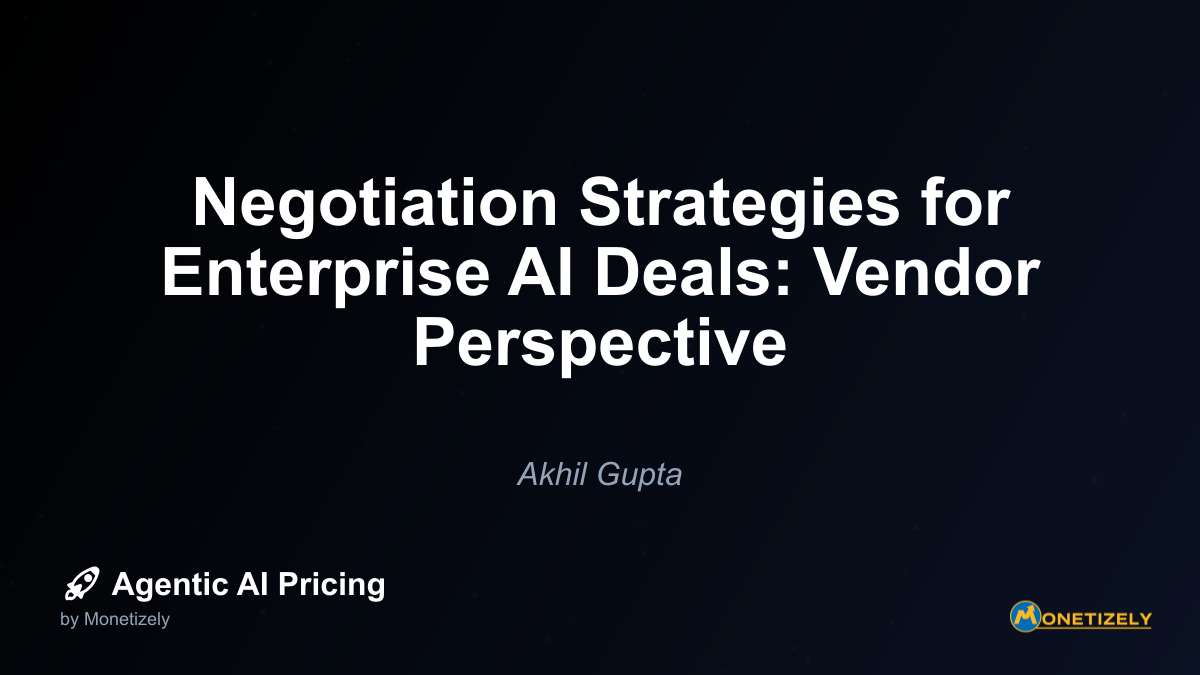
In today’s rapidly evolving enterprise AI landscape, vendors face unique challenges when negotiating large-scale implementation deals. The negotiation table has transformed dramatically with the emergence of AI-powered procurement tools, changing buyer expectations, and complex deployment considerations. For vendors, mastering these negotiations requires a strategic approach that balances value demonstration, technical feasibility, and competitive positioning.
The Evolving Enterprise AI Deal Landscape
Enterprise AI deals have grown increasingly complex, with Gartner predicting that by 2027, half of all companies will use AI in supplier contract negotiations. This represents a significant shift in how both sides approach the negotiation table. Early adopters like Walmart are already efficiently managing thousands of negotiations simultaneously using autonomous agents, achieving up to twice the value opportunities and negotiating on data-driven benchmarks 90% faster than traditional methods.
The stakes are high for vendors. According to recent research, enterprises using AI negotiation platforms report average savings of 1.5-3% on negotiated spend and improvements such as extended payment terms by about 35 days. This puts pressure on vendors to develop sophisticated negotiation strategies that protect margins while delivering compelling value.
“The balance of power has shifted,” notes Dr. Sarah Chen, Chief AI Strategist at Enterprise Solutions Group. “Buyers now come armed with AI-powered market intelligence, predictive pricing models, and automated negotiation assistants. Vendors must adapt or risk being commoditized.”
Understanding the Enterprise Buyer Mindset
Before diving into specific negotiation tactics, vendors must understand what drives enterprise buying decisions for AI implementations. Key motivators include:
ROI and Business Impact: Enterprises increasingly demand clear, measurable business outcomes from AI investments. According to McKinsey’s 2024 State of AI report, 68% of organizations cite measurable ROI as the primary factor in AI purchasing decisions.
Risk Mitigation: With high-profile AI implementation failures making headlines, buyers are increasingly concerned about deployment risks, data security, and compliance issues.
Integration Capability: The ability to integrate with existing systems and workflows ranks among the top three concerns for enterprise buyers, with 73% citing it as critical in vendor selection.
Scalability and Future-Proofing: Enterprises want solutions that can grow with their needs and adapt to changing requirements without requiring complete overhauls.
Total Cost of Ownership: Beyond the sticker price, buyers are increasingly sophisticated about understanding ongoing costs, including infrastructure, maintenance, training, and scaling expenses.
Understanding these drivers allows vendors to position their offerings more effectively during negotiations and anticipate potential objections.
Pre-Negotiation Intelligence Gathering
Successful enterprise AI deal negotiations begin long before the first meeting. The most effective vendors invest heavily in pre-negotiation intelligence gathering to strengthen their position.
Comprehensive Stakeholder Mapping
Enterprise AI deals typically involve multiple stakeholders with different priorities and concerns. A thorough stakeholder mapping exercise should identify:
- Economic Buyers: Those controlling the budget and making final financial decisions
- Technical Evaluators: Those assessing the technical feasibility and integration requirements
- End Users: Those who will actually use the AI solution day-to-day
- Executive Sponsors: Those championing the project at a strategic level
- Potential Blockers: Those who might resist the implementation for various reasons
For each stakeholder, vendors should understand their specific priorities, concerns, and decision criteria. This allows for tailored messaging and negotiation approaches.
Competitive Intelligence
Understanding the competitive landscape is crucial for effective negotiation positioning. This includes:
- Competitor Pricing Models: How do competitors structure their pricing for similar solutions?
- Typical Discounting Patterns: What concessions do competitors typically offer in similar deals?
- Differentiation Points: What unique value can you offer that competitors cannot?
- Recent Wins/Losses: What patterns emerge from recent competitive situations?
“When we analyze enterprise AI deals that close successfully, we find that vendors who can clearly articulate their differentiation relative to specific competitors have win rates 23% higher than those who cannot,” explains Michael Torres, Principal Analyst at Enterprise AI Advisory Group.
Internal Value Assessment
Before entering negotiations, vendors should conduct a rigorous internal assessment of their solution’s value to the specific enterprise. This should include:
- Quantified Business Impact: Specific, measurable outcomes the solution can deliver
- Implementation Timeline and Milestones: Realistic deployment schedules
- Resource Requirements: What the enterprise will need to provide for successful implementation
- Risk Factors: Potential challenges and mitigation strategies
- Customer Success Stories: Similar implementations and their outcomes
This assessment forms the foundation for value-based negotiation approaches rather than purely price-focused discussions.
Strategic Negotiation Frameworks for AI Vendors
With thorough preparation complete, vendors can employ several strategic frameworks to guide their negotiation approach.
The Value-Anchoring Approach
Rather than starting with pricing discussions, successful vendors anchor negotiations around the specific value their AI solution delivers. This approach includes:
- Quantified Business Case: Beginning with a detailed business case showing ROI, cost savings, revenue improvements, or other tangible benefits
- Value Timeline: Mapping when different value components will be realized during the implementation
- Value Guarantees: Offering performance-based pricing components tied to achieving specific outcomes
- Competitive Value Comparison: Demonstrating superior value relative to alternatives, including doing nothing
“When we anchor on value first, we see an average 32% higher deal size compared to when we lead with product features or pricing,” notes Jennifer Park, VP of Enterprise Sales at AI Solutions Inc.
The Solution-Expansion Framework
This approach focuses on starting with a narrower implementation that can expand over time as value is proven:
- Pilot-to-Production Pathway: Clear milestones for moving from initial proof of concept to full deployment
- Modular Solution Architecture: Ability to add capabilities incrementally as needs evolve
- Success-Triggered Expansion: Predefined criteria that trigger expansion to additional use cases or departments
- Enterprise-Wide Vision: Long-term roadmap showing the full potential across the organization
This approach reduces perceived risk for buyers while creating natural upsell opportunities for vendors.
The Partnership Positioning Strategy
For complex, strategic AI implementations, positioning as a long-term partner rather than a transactional vendor can be highly effective:
- Joint Success Definition: Collaboratively defining what success looks like
- Shared Risk Models: Structures where both parties have skin in the game
- Co-Development Opportunities: Potential for joint innovation on future capabilities
- Executive Alignment: Establishing relationships at multiple organizational levels
- Knowledge Transfer Commitments: Ensuring the client builds internal capabilities over time
“The vendors who consistently win large enterprise AI deals are those who approach negotiations as the beginning of a partnership, not the end of a sales process,” observes Dr. Robert Kim, Director of AI Procurement at Global Enterprises Association.
Tactical Negotiation Techniques for Enterprise AI Deals
Within these broader frameworks, several specific tactics have proven effective for AI vendors in enterprise negotiations.
Tiered Pricing Structures
Rather than offering a single price point, successful vendors typically present tiered options that align with different levels of value, capability, and support:
- Basic Tier: Core functionality with standard support
- Professional Tier: Enhanced capabilities with priority support
- Enterprise Tier: Full functionality with dedicated support and custom integration
This approach gives buyers options while steering them toward the vendor’s preferred configuration.
Bundling and Unbundling Strategies
Strategic bundling or unbundling of solution components can significantly impact perceived value and negotiation dynamics:
- Value-Add Bundling: Including high-perceived-value components with low marginal cost
- Strategic Unbundling: Separating components where the client places different value on each element
- Hybrid Models: Core plus optional components to allow customization while maintaining margin
“We’ve found that thoughtful bundling strategies can increase deal size by 27% while actually improving customer satisfaction with the overall value proposition,” reports Alicia Gomez, Chief Revenue Officer at Enterprise AI Systems.
Multi-Year Agreement Incentives
Encouraging longer-term commitments provides revenue predictability for vendors while often appealing to buyers through:
- Escalating Discount Structures: Greater discounts for longer commitments
- Price Protection Guarantees: Insulation from future price increases
- Innovation Access: Priority access to new capabilities as they’re developed
- Dedicated Success Resources: Enhanced support for multi-year customers
Concession Planning and Management
Effective negotiators plan their concessions carefully, understanding both what they can offer and what they expect in return:
- Concession Hierarchy: Predetermined ranking of possible concessions based on cost impact and customer value
- Reciprocity Requirements: Specific asks tied to each potential concession
- Phased Concession Approach: Holding some concessions in reserve for later negotiation stages
- Non-Price Concessions: Alternative concessions that deliver customer value without reducing price
“The most common mistake we see vendors make is offering price concessions too quickly without getting anything in return,” notes Thomas Wilson, Principal at Enterprise Negotiation Advisors. “High-performing vendors have a carefully orchestrated concession strategy that maintains margin while still demonstrating flexibility.”
Technical Considerations in AI Deal Negotiations
Enterprise AI implementations involve significant technical complexity that must be addressed during negotiations to avoid future conflicts and ensure successful deployment.
Integration Requirements and Costs
Vendors must clearly define and negotiate:
- API and Connector Requirements: What interfaces are needed for integration with existing systems
- Data Migration Scope: Volume, cleansing requirements, and responsibility boundaries
- Custom Integration Development: Who will perform this work and at what cost
- Testing and Validation Protocols: Standards for ensuring proper integration
“Integration challenges are the number one reason enterprise AI implementations fail,” warns Dr. Maya Patel, CTO of Enterprise AI Solutions. “These requirements must be explicitly negotiated upfront, not treated as implementation details to be figured out later.”
Infrastructure and Scaling Considerations
AI solutions often have specific infrastructure requirements that impact total cost of ownership:
- Cloud Resource Requirements: Compute, storage, and networking needs
- On-Premises Hardware Specifications: When cloud deployment isn’t feasible
- Scaling Parameters: How resource needs will change as usage grows
- Performance Guarantees: Minimum acceptable performance levels and remedies
Data Governance and Security Requirements
With AI’s heavy dependence on data, these considerations are particularly critical:
- Data Ownership and Usage Rights: Who owns the data and derived insights
- Security Standards and Certifications: Required security measures and compliance
- Audit and Monitoring Capabilities: How system usage and data access will be tracked
- Data Retention and Deletion Policies: How long data will be kept and how it will be removed
“In our analysis of failed enterprise AI negotiations, unclear data governance terms were cited in 47% of cases as a primary reason deals fell apart,” reports Samantha Johnson, Research Director at Enterprise AI Adoption Institute.
Handling Common Enterprise Objections
Even with thorough preparation, vendors will inevitably face objections during enterprise AI negotiations. Having prepared responses to common objections is essential.
”Your solution is too expensive”
Effective responses include:
- Refocusing on ROI and total value delivered
- Comparing total cost of ownership to alternatives
- Offering phased implementation to spread costs
- Exploring alternative pricing models that better align with the customer’s value perception
”We need to evaluate more vendors”
Responses might include:
- Proposing a time-limited proof of concept to demonstrate value
- Offering customer references with similar use cases
- Providing competitive comparison matrices highlighting your advantages
- Suggesting a phased evaluation that allows for parallel progress
”We don’t have the internal resources to implement this”
Address this with:
- Detailing your implementation support services
- Proposing managed service options for ongoing operation
- Sharing case studies of successful implementations with similar resource constraints
- Offering training and knowledge transfer programs
”We’re concerned about the risks of AI implementation”
Counter with:
- Describing your risk mitigation methodology
- Offering phased deployment with clear go/no-go decision points
- Proposing performance guarantees or risk-sharing models
- Detailing your security, compliance, and governance frameworks
Deal Structures and Pricing Models
The structure of enterprise AI deals has evolved significantly, with several models emerging as particularly effective.
Consumption-Based Pricing
This model ties costs directly to usage, which can include:
- API Call Volume: Charging based on number of API requests
- Compute Resource Consumption: Billing based on processing power used
- Data Volume Processed: Pricing tied to the amount of data analyzed
- User Activity Metrics: Charges based on active users or user actions
“Consumption-based models have grown from 15% of enterprise AI deals in 2023 to 37% in 2025, reflecting both vendor preference for predictable utilization revenue and customer desire to align costs with actual value received,” notes William Zhang, Senior Analyst at AI Market Intelligence.
Outcome-Based Pricing
These models tie compensation directly to business results:
- Performance Improvement Shares: Vendor receives a percentage of documented improvements
- Success Fees: Additional payments triggered when specific outcomes are achieved
- Risk-Reward Models: Lower base fees with significant upside for exceeding targets
- Guaranteed Minimum Outcomes: Refunds or credits if results fall short of agreed targets
Hybrid Subscription + Consumption Models
Many vendors are finding success with hybrid approaches:
- Base Subscription + Overage: Fixed fee for expected usage with charges for exceeding thresholds
- Tiered Consumption Rates: Decreasing per-unit costs as volume increases
- Subscription + Success Fees: Fixed recurring revenue plus performance bonuses
- Reserved Capacity + On-Demand: Committed resources at preferential rates with flexible additional capacity
“The most successful enterprise AI vendors are moving toward hybrid models that provide them baseline revenue predictability while giving customers the flexibility they need,” explains Dr. Olivia Chen, Professor of AI Economics at Stanford Business School.
Negotiation Process Management
How vendors manage the negotiation process itself can significantly impact outcomes.
Setting the Negotiation Cadence
Successful vendors actively manage the pace and structure of negotiations:
- Milestone-Based Approach: Breaking the process into clear stages with defined outcomes
- Decision Timeframes: Establishing realistic but firm timelines for key decisions
- Stakeholder Engagement Plan: Scheduling when different stakeholders need to be involved
- Escalation Pathways: Predefined processes for handling roadblocks
Documentation and Communication Protocols
Clear documentation throughout the negotiation process helps prevent misunderstandings and builds trust:
- Meeting Summaries: Documenting discussions, decisions, and next steps
- Proposal Version Control: Clearly tracking changes between proposal versions
- Assumption Documentation: Explicitly stating the assumptions underlying proposals
- Communication Channels: Establishing preferred methods for different types of communications
Building Negotiation Teams
Complex enterprise AI deals often require specialized negotiation teams:
- Technical SMEs: Subject matter experts who can address implementation questions
- Financial Specialists: Those who can discuss pricing models and ROI calculations
- Legal Experts: Professionals familiar with AI-specific contractual considerations
- Executive Sponsors: Senior leaders who can engage with customer executives
“Vendors who bring cross-functional negotiation teams to enterprise AI deals see 28% higher close rates and 17% larger deal sizes compared to those relying primarily on sales representatives,” reports Enterprise AI Quarterly in their 2025 benchmark study.
Case Studies: Successful Enterprise AI Negotiations
Microsoft (Azure + OpenAI partnerships)
Microsoft enabled companies like CarMax and Persistent Systems to implement AI-powered solutions integrated with Microsoft 365 Copilot. Persistent Systems deployed “Contract Assist,” reducing negotiation emails by 95% and shortening negotiation time by 70%.
These deals often involved customized AI integration and a pricing model aligned with enterprise cloud service consumption, allowing flexible scaling from pilot to full deployment. Concessions included tailored product development cycles and robust enterprise support, leading to streamlined contracts and improved efficiency in negotiations and internal processes.
Key Success Factors:
- Alignment of pricing with cloud consumption patterns familiar to enterprise customers
- Phased deployment approach that reduced perceived implementation risk
- Strong integration with existing Microsoft products already in use
Luminance AI
This vendor provided AI-powered negotiation tools for enterprises like NTT Data and Advanced Micro Devices (AMD). Luminance’s AI helped firms model negotiation preferences, optimize contract clauses, and autonomously markup legal contracts (e.g., NDAs).
Negotiation tactics included iterative AI training through repeated rounds with suppliers to improve price outcomes, with humans retaining final approval. For AMD, this semi-autonomous approach allowed faster closing of contracts with reduced human workload. Pricing was linked to usage and customization complexity. Concessions typically focused on ensuring human oversight and a gradual handover from AI-assisted to semi-autonomous negotiation phases, fostering trust and ensuring contractual quality.
Key Success Factors:
- Clear demonstration of specific workflow improvements and time savings
- Gradual implementation approach that built trust in the AI system
- Pricing tied directly to measurable efficiency gains
AI-Powered Supplier Negotiation Platforms
One reported case showed a 40% cost reduction by employing AI-powered scenario modeling to evaluate thousands of contract permutations. The AI helped assess trade-offs in pricing, volume, and risk-sharing provisions.
Human teams combined their expertise with AI insights to negotiate stronger contracts resilient to market fluctuations. Pricing structures likely involved subscription plus performance-based fees. Concessions focused on flexible contract terms that adapted to economic changes while protecting both parties’ interests.
Key Success Factors:
- Performance-based pricing components that demonstrated vendor confidence
- Clear quantification of business impact with specific metrics
- Balance between AI automation and human expertise
Emerging Trends in Enterprise AI Deal
Co-Founder & COO
Akhil is an Engineering leader with over 16+ years of experience in building, managing and scaling web-scale, high throughput enterprise applications and teams. He has worked with and led technology teams at FabAlley, BuildSupply and Healthians. He is a graduate from Delhi College of Engineering and UC Berkeley certified CTO.
Pricing Strategy Audit
Let our experts analyze your current pricing strategy and identify opportunities for improvement. Our data-driven assessment will help you unlock untapped revenue potential and optimize your AI pricing approach.

